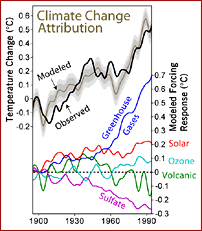Global Warming -- Research Issues
Global Warming
Latest News
Solar Influences on Climate
(Latest research determines Sun is not the cause of global warming)
New Sunspot Count Techniques Rule Out Sun as Perpetrator of Global Warning
97% of Climate Science Papers Agree Warming is Man-Made
 Translation into Portuguese
provided by homeyou.com Translation into Portuguese
provided by homeyou.com
What is it?
Global Warming -- a gradual increase in planet-wide temperatures
-- is now well documented and accepted by scientists as fact. A panel convened
by the U.S National Research Council, the nation's premier science policy body,
in June 2006 voiced a "high level of confidence" that Earth is the hottest it
has been in at least 400 years, and possibly even the last 2,000 years. Studies
indicate that the average global surface temperature has increased by approximately
0.5-1.0°F (0.3-0.6°C) over the last century. This is the largest increase
in surface temperature in the last 1,000 years and scientists are predicting
an even greater increase over this century. This warming is largely attributed
to the increase of greenhouse gases (primarily carbon dioxide and methane) in
the Earth's upper atmosphere caused by human burning of fossil fuels, industrial,
farming, and deforestation activities.
Average global temperatures may increase by 1.4-5.8ºC (that's 2.5 -
10.4º F) by the end of the 21st century. Although the numbers sound small,
they can trigger significant changes in climate. (The difference between global
temperatures during an Ice Age and an ice-free period is only about 5ºC.)
Besides resulting in more hot days, many scientists believe an increase in
temperatures may lead to changes in precipitation and weather patterns. Warmer
ocean water may result in more intense and frequent tropical storms and hurricanes.
Sea levels are also expected to increase by 0.09 - 0.88 m. in the next century,
mainly from melting glaciers and expanding seawater . Global Warming may also
affect wildlife and species that cannot survive in warmer environments may
become extinct. Finally, human health is also at stake, as global Climate Change
may result in the spreading of certain diseases such as malaria, the flooding
of major cities, a greater risk of heat stroke for individuals, and poor air
quality.
Climate change is very likely having an impact now on our planet and its
life, according to the latest installment of a report published by the Intergovernmental
Panel on Climate Change (IPCC). And the future problems caused by rising seas,
growing deserts, and more frequent droughts all look set to affect the developing
world more than rich countries, they add. The report is the second chapter
of the IPCC's Fourth Assessment -- the most comprehensive summary yet of research
into the causes and effects of climate change. To read more, visit
Effects of climate change tallied up.
Back to Top
Factors
Greenhouse Gases
The increase in greenhouse gases caused
by human activity is often cited as one of the major causes of global warming.
These greenhouse gases reabsorb heat reflected from the Earth's surface,
thus trapping the heat in our atmosphere. This natural process is essential
for life on Earth because it plays an important role in regulating the Earth's
temperature. However, over the last several hundred years, humans have been
artificially increasing the concentration of these gases, mainly carbon
dioxide and methane in the Earth's atmosphere. These gases build up and
prevent additional thermal radiation from leaving the Earth, thereby trapping
excess heat.
Solar Variability & Global Warming
 During the initial discovery period of global climate change, the magnitude
of the influence of the Sun on Earth's climate was not well understood.
Since the early 1990s, however, extensive
research was put into determining what role, if any, the Sun has in global
warming or climate change.
During the initial discovery period of global climate change, the magnitude
of the influence of the Sun on Earth's climate was not well understood.
Since the early 1990s, however, extensive
research was put into determining what role, if any, the Sun has in global
warming or climate change.
A recent review paper, put together by both solar and climate scientists,
details these studies:
Solar Influences on Climate.
Their bottom line: though the Sun may play some small role,
"it is nevertheless much
smaller than the estimated radiative forcing due to
anthropogenic changes." That is, human activities are the
primary factor in global climate change.
 Solar irradiance changes have been measured reliably by satellites
for only 30 years. These precise observations show changes of a few tenths
of a percent that depend on the level of activity in the 11-year solar cycle.
Changes over longer periods must be inferred from other sources. Estimates
of earlier variations are important for calibrating the climate models.
While a component of recent global climate change may have been caused by the increased
solar activity of the last solar cycle, that component was very small compared
to the effects of additional greenhouse gases. According to a NASA Goddard
Institute for Space Studies (GISS) press
release, "...the solar increases do not have the ability to cause
large global temperature increases...greenhouse gases are indeed playing
the dominant role..." The effects of global climate change are apparent (see section below) despite the fact that the Sun is once again less bright during the present
solar minimum. Since the last solar minimum of 1996, the Sun's
brightness has decreased by 0.02% at visible wavelengths,
and 6% at extreme UV wavelengths, representing a 12-year low in solar irradiance, according to this
NASA news article (April 1, 2009).
Also, be sure to read this more recent article: 2009: Second Warmest Year on Record; End of Warmest Decade.
Solar irradiance changes have been measured reliably by satellites
for only 30 years. These precise observations show changes of a few tenths
of a percent that depend on the level of activity in the 11-year solar cycle.
Changes over longer periods must be inferred from other sources. Estimates
of earlier variations are important for calibrating the climate models.
While a component of recent global climate change may have been caused by the increased
solar activity of the last solar cycle, that component was very small compared
to the effects of additional greenhouse gases. According to a NASA Goddard
Institute for Space Studies (GISS) press
release, "...the solar increases do not have the ability to cause
large global temperature increases...greenhouse gases are indeed playing
the dominant role..." The effects of global climate change are apparent (see section below) despite the fact that the Sun is once again less bright during the present
solar minimum. Since the last solar minimum of 1996, the Sun's
brightness has decreased by 0.02% at visible wavelengths,
and 6% at extreme UV wavelengths, representing a 12-year low in solar irradiance, according to this
NASA news article (April 1, 2009).
Also, be sure to read this more recent article: 2009: Second Warmest Year on Record; End of Warmest Decade.
Back to Top
Trends & Effects; Scientific
Studies
 Image created by Robert A. Rohde / Global Warming Art
Image created by Robert A. Rohde / Global Warming Art
|
The United
Nations Intergovernmental Panel on Climate Change has been studying
global warming for years. Their most recent report, issed in February
2007, (see Climate Change
2007: The Physical Science Basis (summary for policymakers),
U.N. Report Confirms Human Activity to Blame for Earth's Warming Climate
(from Voice of America), and Intergovernmental
Panel on Climate Change), concludes that "The global increases in
carbon dioxide concentration are due primarily to fossil fuel use and
land-use change, while those of methane and nitrous exide are primarily
due to agriculture." The report goes on to note that these findings
come with a "very high confidence rate [words emphasized in italics
in the report summary] that the globally averaged net effect of human
activities since 1750 has been one of warming."
|
The primary place where scientific studies related to global climate change are
reported is the American Geophysical Union (AGU). Based on the outcome from
a considerable number of studies in various fields related to global climate change,
the AGU has issued a statement:
Society Must Address the Growing Climate Crisis Now.
The American Meteorological Society, which promotes the development and
dissemination of information and education on the atmospheric and related
oceanic and hydrologic sciences, has also issued a statement
on global changes.
Additional discussion on current and potential future effects and feedback mechanisms can be found here: Effects of global warming.
Back to Top
Frequently
Asked Questions
- Where
is the data that show global warming is largely attributed to the increase
of greenhouse gases (primarily carbon dioxide and methane) in the Earth's
upper atmosphere caused by human burning of fossil fuels?
- To
what extent does the Sun's variability affect and/or cause global climate
change?
- My
spiritual leaders disagree with the scientists, how do I determine whom
to believe?
Back to Top
Where Do I Learn
More?
The Role of the Sun in Climate Change by Douglas
V. Hoyt and Kenneth Schatten; Oxford University Press, 1997. ISBN: 0195094131
"Plows, Plagues, and Petroleum: How Humans Took Control
of Climate" by William F. Ruddiman; Princeton University Press (2005);
ISBN: 0691121648
An excellent book, written by one of the world's
top paleoclimatologists, but understandable to both scientist and nonscientists
alike. Ruddiman summarizes, explains with research and facts, and places in
context the influence of humans on atmospheric composition, climate and global
warming. His focus is on the big picture -- changes to climate over the last
400,000 years with special attention to changes beginning 8,000 years ago.
He makes only brief mention of solar variability as affecting climate (because
his focus is on longer trends), but he does an excellent job of describing
how small complications in the Earth's orbit cause regular glaciation on 100,000,
41,000, and 22,000 year timeframes. Note that a primary hypothesis of his
book is the suggestion that early human agriculture started having an effect
on the Earth's climate as early as 8,000 years ago. This is an intriguing
idea which is still waiting for further scientific verification or discredit.
However, the information in Ruddiman's book is still immensely useful in understanding
current global warming and climate change.
"Ancient Observations Link Changes in Sun's Brightness
and Earth's Climate" by Kevin D. Pang and Kevin K. Yao; EOS, Transactions
of the American Geophysical Union, Volume 83, number 43, 22 October 2002,
pages 481+.
This is an article written for scientists. The authors
track 9 cycles of changes in solar brightness over the last 1800 years, and
then correlate these with various changes in the Earth's climate. As you undoubtedly
know, an especially suspicious correlation is that of a period of no sunspots
(and hence low solar activity) corresponding with the Maunder Minimum of ~1645
to 1715 A.D, a period of extreme cold in Europe. Because of the complexity
of effects on the Earth's climate, the jury is still out on whether this period
of a Little Ice Age was indeed caused by the lack of solar activity. However,
the correlations are intriguing and continue to be discussed at scientific
meetings such as the AGU. You can find lots more about the Maunder Minimum
and its relationship to sunspots on the web.
Back to Top
| |

